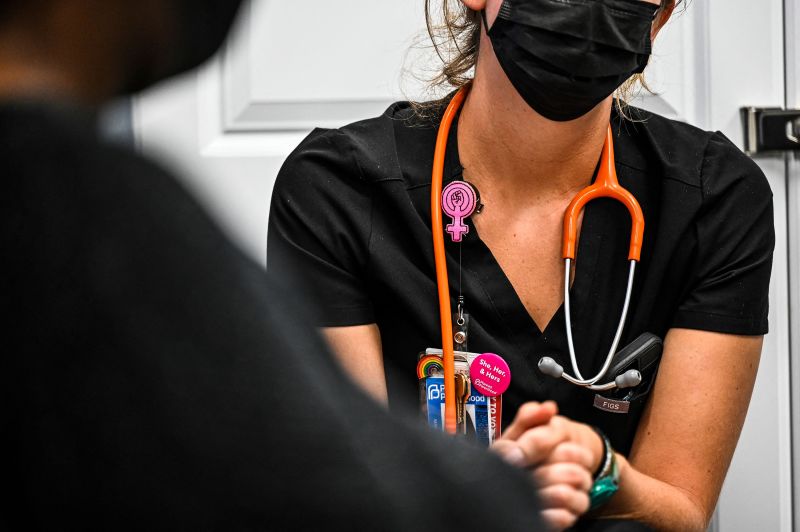A stricter abortion law is set to take effect in Florida on Wednesday — dropping the state’s 15-week ban to a six-week ban — and it will likely affect thousands of people seeking abortion care within the first month alone.
Florida has become a key abortion access point amid widespread restrictions that have taken hold in the region in the two years since the US Supreme Court’s Dobbs decision overturned Roe v. Wade. It’s also one of the country’s most populous states.
Last year, 1 of every 3 abortions in the South — and about 1 in every 12 nationwide — happened in Florida, according to data from the Guttmacher Institute, a research and policy organization focused on sexual and reproductive health that supports abortion rights. In 2023, there were about 7,000 abortions in Florida each month, and more than 9,000 people traveled from other states to get an abortion in Florida throughout the year, the data shows.
Many women don’t know that they’re pregnant six weeks after their last menstrual period, and other states that have enacted laws with this early gestation limit saw significant cuts to abortion care. In Texas, the number of abortions provided within the formal health-care system dropped by about half after a six-week abortion ban took effect in 2021, and there were thousands more births than expected in the following year. In South Carolina, there was a 70% decrease in abortions just one month after the state enforced a six-week limit.
But tighter restrictions in Florida could have an even more significant effect than historical trends suggest because Florida has been absorbing patients from other states that already have stricter limits. So far this year, more than 1,300 people from other states have traveled to Florida for an abortion, according to data from the state health agency — nearly a tenth of all abortions in the state so far in 2024.
Of the 16 states in the South, nine have banned abortion. Florida will join Georgia and South Carolina with a six-week ban. This leaves just three states in this US Census region — Delaware, Maryland and Virginia — where abortion remains legal past the first trimester and North Carolina with a 12-week limit.
A 2022 study found that the average travel time to an abortion facility more than tripled in the first few months after the Dobbs decision. The effects were significantly severe in some southern states such as Texas and Louisiana, where average travel times to the nearest abortion facility were seven hours longer, adding nearly a full workday in travel time to get an abortion.
For that study, researchers considered abortion facilities in states with complete bans and those with six-week limits to be inactive. The newly implemented bans cut the number of active providers by about a tenth. In the year and a half since, the abortion landscape in the US has only become more fractured, and Florida’s new six-week ban would affect a significant number of facilities that remain in the South.
Providers and patients have had 30 days to prepare since the Florida Supreme Court first posted the decision that paved the way for the new restrictions.
Amber Gavin, vice president of advocacy and operations for A Woman’s Choice, an independent abortion clinic with locations in Florida, North Carolina and Virginia, said that questions from patients started pouring in right after the April 1 ruling. Any time abortion is in the news, chaos and confusion follow, she said.
The clinic in Florida is committed to staying open and providing care as long as it can — and ensuring that’s communicated well, Gavin said. It’s also preparing for the possibility of another change come November.
Florida is one of three states, along with Maryland and New York, that has secured abortion measures on the 2024 election ballot. In Florida, the Amendment to Limit Government Interference with Abortion would protect the right to an abortion up to the point of “viability” or to protect the patient’s health as determined by their health care provider. Ten other states are considering adding abortion-related measures, some to protect access and others that could restrict access.
“(The Florida Supreme Court decision) was a really worst-case scenario decision for us because it did overturn 40 years of precedent,” Gavin said. “But I think it also hopefully will motivate folks and get folks out in November to make sure that the government isn’t interfering in these really personal decisions.”
In the meantime, abortion funds across the US are preparing for a surge in need from patients who may be displaced by Florida’s more restrictive law.
The Tampa Bay Abortion Fund anticipates that at least 90% of people who call their hotline will be impacted by a six-week abortion ban and will need to seek abortion care outside of Florida. The Chicago Abortion Fund has bolstered programs and capacity in direct anticipation of this decision from Florida’s high court, and staffers estimate that they’ll need an additional $100,000 each month to absorb the surge of Floridians and other Southerners seeking support for an abortion.
“Every caller to TBAFund is already facing one or more barriers to care, such as a lack of funding, transportation, childcare, or a nearby abortion clinic in their community. The six-week ban will only exacerbate those barriers in the cruelest fashion,” Kris Lawler, president of the Tampa Bay Abortion Fund Board said in a statement.
